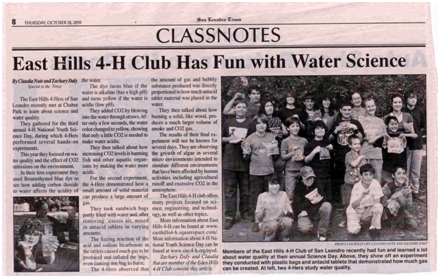4-H Delivers
National 4-H Youth Science Experiment in Alameda County
The Issue:
The 4-H National Youth Science Day supports the National 4-H Science Initiative and is designed to engage youth in science experiments. The National Science Experiment encourages youth to participate in a science experiment simultaneously with other 4-H youth across the country. The experiments also tie into the 4-H SET (Science, Engineering, and Technology) initiative which is designed to promote science among youth and create one million new scientists. The 2010 National Science Experiment, 4-H2O, was designed to increase awareness about water quality and the effects of heighted carbon dioxide emissions, using a three-tiered experiment model. Water quality not only affects drinking water, but also the natural habitats of aquatic plants, animals and organisms.
What has 4-H Done?:
Youth in Alameda County participated in three experiments to learn these issues. In the first experiment, youth blew on bromothymol blue indicator solution mixed with water in order to show how carbon dioxide levels can build up in water which was demonstrated by the indicator changing from blue to yellow. This reaction showed that only a small amount of carbon dioxide is needed to make water acidic. The second part of the experiment illustrated the concept of how carbon dioxide expands in Earth’s atmosphere. Youth added antacid tablets in varying amounts to sandwich bags, which represented Earth’s ability to capture greenhouse gases, that contained water and had had the excess air removed. As the antacid tablets reacted with the water, the resulting carbon dioxide inflated the bag. The final part of the 2010 National 4-H experiment conceptualized how algae use sun and the process of photosynthesis to grow. Youth observed how higher levels of carbon dioxide resulted in higher air temperatures and therefore increased algae growth.
The Payoff:
The 4-H members throughout Alameda County learned about carbon dioxide, the buildup of it, and the effects of it on water quality through hands-on learning, as well as being involved in a discussion about overall climate change and water quality. The youth learned to observe the key characteristics of water quality, such as color, odor, and the presence of aquatic plants and animals. The members were engaged in seeing the human contribution of carbon dioxide and learning about the effects that this particular greenhouse gas has on life on Earth.




